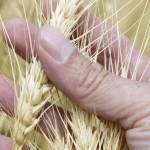Check Horse Pastures for Forbidden Fruits

Horses often explore new surroundings by nibbling anything that seems edible, including many fruits and vegetables. With this in mind, you can see why you need to check any unfamiliar pasture before turning out horses to graze. This includes any time you move your horse to a new boarding stable or to property you own and have recently decided to use as pasture. Anything that’s within, or not too far outside of, the fence will probably be sampled by curious horses, and some of those things might not be desirable portions of a healthy equine diet.
Hay fields. Before horses are turned out in a field that has been mowed for hay some time ago, check for piles of hay that were raked but not gathered for baling. These piles frequently contain mold and should not be eaten by horses.
Cropland. Corn, soybeans, oats, and other crops may have been harvested from a field that is now going to be used for pasture. Check for large amounts of leftover grain; horses can probably pick up a bit of corn or oats from the ground without a problem, but if there is a significant amount, they might overindulge or ingest moldy grain.
Trees. Mature trees provide shade during hot weather, but some trees are dangerous for horses. Wilted wild cherry and maple leaves have dangerous concentrations of toxins, for example, and other tree species such as oaks produce seeds that are toxic if large quantities are eaten.
Orchards. An abandoned apple orchard might seem harmless, but overconsumption of any type of fruit, whether immature or ripe, can cause digestive upsets in horses. Fruit also poses a choking hazard for horses that may eat too fast without chewing. Leaves, sap, and bark may contain substances that are irritating to a horse’s lips and tongue.
Walking the interior of the pasture as well as all fence lines will allow owners to find trees and remnants of previous crops that may pose a danger to horses. Also, each horse may have a different taste for novel vegetation, so if some horses ignore those crabapple trees on the back fence, don’t assume your new horse will do the same. If you’re not sure about whether a particular tree or crop could be hazardous, ask your veterinarian or check with the local agricultural extension agent. These hazards should be removed or fenced off before horses are allowed free pasture access.








